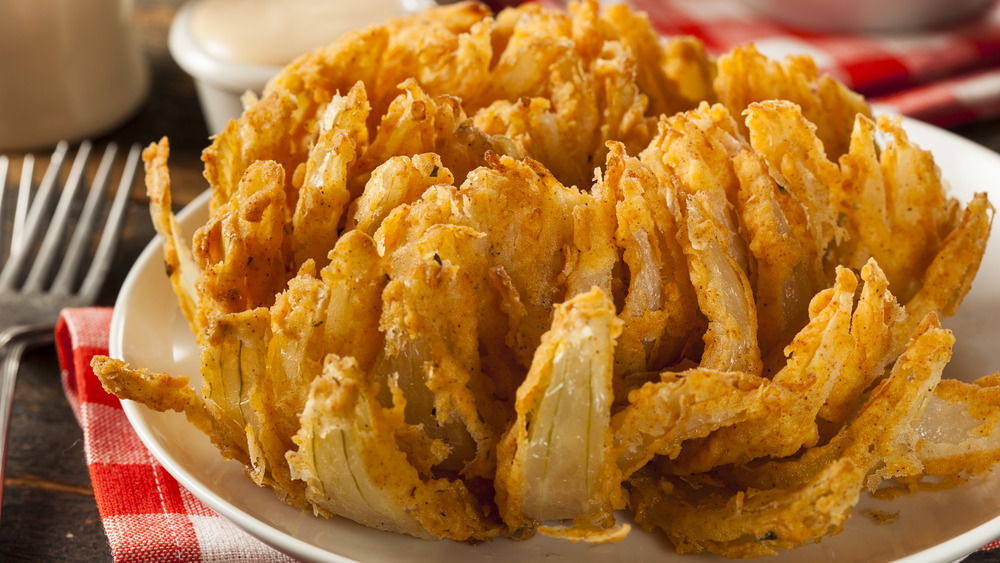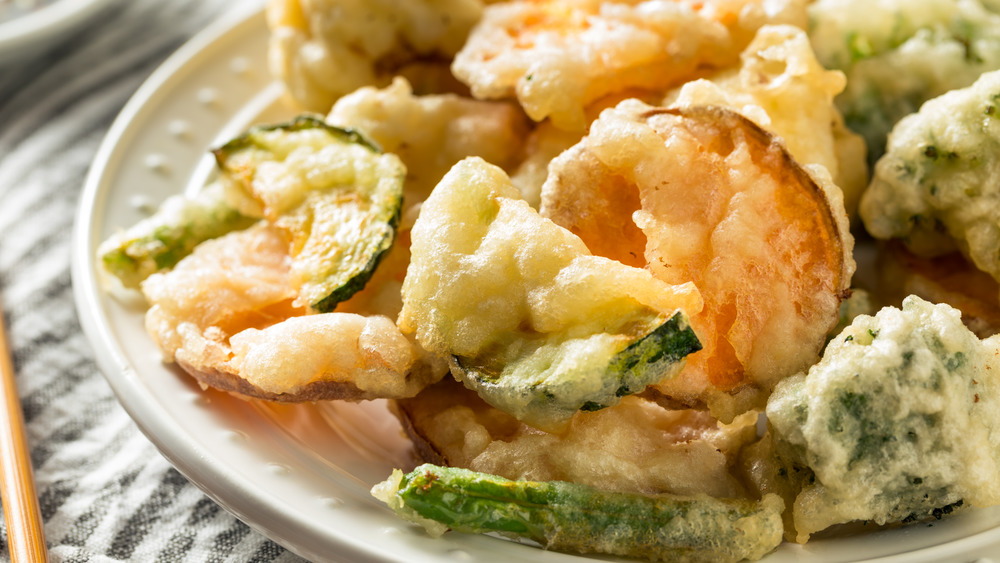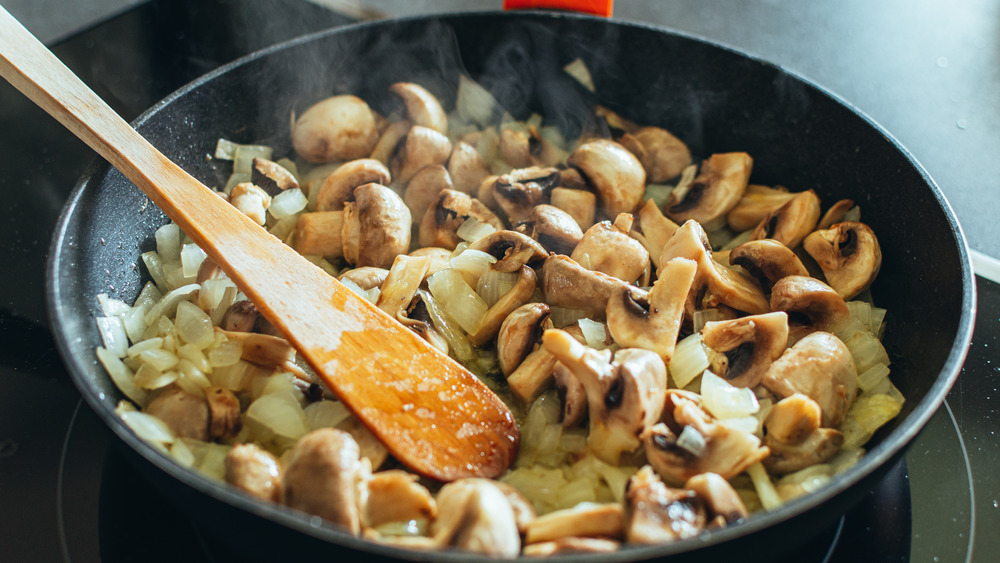Are Fried Vegetables Actually Good For You?
Even if you are a confirmed veggie hater, there are probably a few forms of former plant life you actually enjoy. French fries, sweet potato fries, deep-fried corn, fried mushrooms, fried pickles (cucumbers are vegetables, after all)... Even the most hardcore of carnivores would not say no to a Bloomin' Onion before carving into one of Outback's signature steaks. Hmm, starting to see a pattern here? Yes, the one thing all these veggies have in common is that they would be right at home at the state fair — all that is missing is the stick.
In other words, they are all bread- or batter-dipped and deep fried, yum! While the deep fryer treatment will not rescue every veggie — there's a reason you do not see fried beet chips or broccoli poppers on too many menus — it can sure add some serious tastiness to certain members of the vegetable kingdom.
But yes, sigh, we cannot exactly claim to be eating healthy just because we had a double portion of fries with our burger, now can we? While we might get some potato points for downing a plain baked tuber, nobody has ever tried to claim that fries are health food (although President Reagan did once claim that ketchup could be considered a vegetable). We spoke to registered dietitian Sue Heikkinen of MyNetDiary about fried vegetables and, even though the nutrition expert confirmed what we already knew about their unhealthy side, she did tell us that fried veggies do offer a few surprising health benefits, as well.
Fried vegetables are way more fattening
The biggest problem with fried vegetables, health-wise, as registered dietitian Sue Heikkinen of MyNetDiary points out, is the fact that they provide "added calories in the form of fat from the cooking oil and carbs from the batter or breading." As an example, Heikkinen notes that an order of fried zucchini from Carl's Jr. (yes, the chain really does carry such a thing... who knew people actually paid for the veggie version of a white elephant gift?) has 330 calories, whereas a raw medium zucchini, according to My Net Diary, has just 33 calories. The breading and the frying, in this case, boosted the calorie count by a whopping 900 percent.
Heikkinen also adds that the fried zucchini is even higher in calories than a small order of fries from Carl's Jr., as one of those comes in at only 300 calories. My Food Diary gives the size of this portion as 104 grams, whereas a similar portion of plain potato would only be about 100 calories. That is a mere 200 percent calorie bump, but then again, French fries are rarely battered or breaded, so they might actually be a better bet for calorie counters than other types of fried veggies.
Fried veggies may have more vitamins and minerals
There are good tidings for those who prefer their vegetables fried, however. Sue Heikkinen of MyNetDiary brings the welcome news that "frying actually reduces the loss of minerals such as potassium and the water-soluble B-vitamins and vitamin C compared to boiling, which leeches some of these nutrients into the cooking water." Good, because boiling veggies has to be the most blah way of cooking there is, rendering them soggy and lifeless and adding nothing to the flavor.
Heikkinen also notes that "because vegetables are typically fried quickly, there is less loss of heat-sensitive folate and vitamin C compared to longer, high-temperature cooking methods." What is more, she adds that a little oil along with our veggies helps us absorb fat-soluble vitamins A, D, E, and K, as well as certain fat-soluble nutrients, such as the lycopene found in tomatoes (and ketchup). But, as a nutritionist, Heikkinen does not want people to "use this as an excuse to opt for fried veggies," instead advising that "a drizzle of olive oil, a spoonful of hummus, or a sprinkle of toasted walnuts will do the trick." Plus, although many cooking oils do contain vitamin E, she says that some of the vitamin content is destroyed by high heat and warns people not to "rely on fried veggies as a source" of said nutrient. Bummer. Still, fried veggies offer some unexpected nutritional value, which is more than we would have dared to hope for in general.
The healthiest way to enjoy fried veggies
If you want the healthiest fried veggies, registered dietitian Sue Heikkinen of MyNetDiary says you should "start with high-nutrient vegetables to get the biggest bang for the (calorie) buck," and suggests using sweet potatoes, bell peppers, or broccoli. The frying methods she favors use "healthier oils, no or minimal breading/batter, shorter cooking times, and moderate temperatures." As to what constitutes a healthier oil, she says harmful trans fats are no longer a problem since they are mostly banned in the U.S., but advises avoiding palm oil as it is high in saturated fat. Heikkinen also explains that "batter and breading [act] as a sponge that soaks up cooking oil," so she says fried vegetables should have "only a light batter or breading, or better yet, none at all."
Although deep-frying may be more flavorful, neither stir-frying nor sautéing involve immersion in oil, thus adding fewer calories. Heikkinen advocates both methods as being "healthy and tasty way[s] to cook vegetables," and also favors air frying since minimal oil is used here, too. She summed up her assessment of fried veggies by saying: "Enjoy [them] in moderation if you love the taste, but don't fool yourself into thinking you are eating a salad." Unless, of course, you are doing all the wrong things with your salad, too... but a little common sense goes a long way when it comes to striking a balance between good taste and good nutrition.



